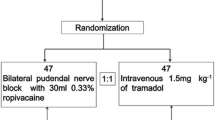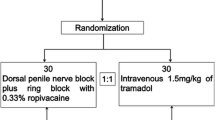Abstract
Purpose
Urethral pain syndrome is a chronic condition characterized by disturbing feeling or server pain sensed at the urethra without specific treatment. This double-center, two-arm controlled trial aimed to explore the efficacy of electrical pudendal nerve stimulation (EPNS) versus intravesical instillation (II) of heparin and alkalinized lidocaine for urethral pain syndrome (UPS).
Methods
Eighty eligible patients took three sessions of EPNS, or 1 session of II per week, for 6 consecutive weeks. The primary end point was the change of pelvic pain and urgency/frequency symptom (PUF) score from baseline to week 6. Secondary outcome measures included changes of visual analogue scale (VAS) score and three sub-score extracted from PUF score.
Results
The enrolled participants were all included in the intention-to-treat analyses, and baseline characteristics between the two groups were well balanced. The post-treatment PUF score decreased by 10.0 (7.00, 16.50) in the EPNS group, and by 7.0 (3.00, 10.00) in the II group. At the closure of treatment, the medians of changes in symptom score, bother score, pain-related score and VAS score were 6.50 (4.25, 10.00), 4.00 (2.00, 6.00), 6.00 (5.00, 8.00),4.50 (2.25, 6.00), respectively, in the EPNS group, and 4.00 (2.00, 7.00), 3.00 (1.00, 3.00), 3.00 (2.00, 6.00), 2.00 (1.00, 4.00), respectively, in the II group. All the between-group differences were statistically significant.
Conclusion
Compared with the II, the EPNS results in superior pain control and better relief of lower urinary tract symptoms, and deserves further attention.
Trial registration
ClinicalTrials.gov (NCT03671993)
Similar content being viewed by others
Data availability
SY Wang had full access to all the data in the study and takes responsibility for the integrity of the data. Data are available for bona fide researchers who request it from the authors.
References
Engeler D, Berghmans B, Baranowski AP, Borovicka J et al (2021) EAU guidelines on chronic pelvic pain. European Association of Urology. https://uroweb.org/wp-content/uploads/EAU-Guidelines-on-Chronic-Pelvic-Pain-2021.pdf
Martinez-Bianchi V, Halstater BH (2010) Urologic chronic pelvic pain syndrome. Prim Care 37(3):527–VIII. https://doi.org/10.1016/j.pop.2010.05.002
Dreger NM, Degener S, Roth S et al (2015) Das urethralsyndrom: fakt oder Fiktion–ein update [Urethral pain syndrome: fact or fiction–an update]. Urologe A 54(9):1248–1255. https://doi.org/10.1007/s00120-015-3926-9
Parsons CL (2011) The role of a leaky epithelium and potassium in the generation of bladder symptoms in interstitial cystitis/overactive bladder, urethral syndrome, prostatitis and gynaecological chronic pelvic pain. BJU Int 107(3):370–375. https://doi.org/10.1111/j.1464-410X.2010.09843.x
Parsons CL, Zupkas P, Parsons JK (2001) Intravesical potassium sensitivity in patients with interstitial cystitis and urethral syndrome. Urology 57(3):428–432. https://doi.org/10.1016/s0090-4295(00)01110-9
Price WE (1990) The urethral syndrome: myth or reality? A commentary. Minn Med 73(9):33–34
Parsons CL (2005) Successful downregulation of bladder sensory nerves with combination of heparin and alkalinized lidocaine in patients with interstitial cystitis. Urology 65(1):45–48. https://doi.org/10.1016/j.urology.2004.08.056
Wang S, Zhang S, Zhao L (2014) Long-term efficacy of electrical pudendal nerve stimulation for urgency-frequency syndrome in women. Int Urogynecol J 25(3):397–402. https://doi.org/10.1007/s00192-013-2223-7
Moher D, Hopewell S, Schulz KF et al (2012) CONSORT 2010 explanation and elaboration: updated guidelines for reporting parallel group randomised trials. Int J Surg 10(1):28–55. https://doi.org/10.1016/j.ijsu.2011.10.001
MacPherson H, Altman DG, Hammerschlag R et al (2010) Revised standards for reporting interventions in clinical trials of acupuncture (STRICTA): extending the CONSORT statement. J Altern Complement Med 16(10):ST1–ST14. https://doi.org/10.1089/acm.2010.1610
Li T, Feng X, Lv J et al (2018) Short-term clinical efficacy of electric pudendal nerve stimulation on neurogenic lower urinary tract disease: a pilot research. Urology 112:69–73. https://doi.org/10.1016/j.urology.2017.10.047
Parsons CL, Dell J, Stanford EJ et al (2002) Increased prevalence of interstitial cystitis: previously unrecognized urologic and gynecologic cases identified using a new symptom questionnaire and intravesical potassium sensitivity. Urology 60(4):573–578. https://doi.org/10.1016/s0090-4295(02)01829-0
Ng CM, Ma WK, To KC et al (2012) The Chinese version of the pelvic pain and urgency/frequency symptom scale: a useful assessment tool for street-ketamine abusers with lower urinary tract symptoms. Hong Kong Med J 18(2):123–130
Parsons CL (2003) Prostatitis, interstitial cystitis, chronic pelvic pain, and urethral syndrome share a common pathophysiology: lower urinary dysfunctional epithelium and potassium recycling. Urology 62(6):976–982. https://doi.org/10.1016/s0090-4295(03)00774-x
Gregory NS, Terkawi AS, Prabhakar NK et al (2020) Peripheral nerve stimulation for pudendal neuralgia: a technical note. Pain Med 21(Suppl 1):S51–S55. https://doi.org/10.1093/pm/pnaa171
Onda A, Uchida S, Suzuki H et al (2016) Stimulus frequency-dependent inhibition of micturition contractions of the urinary bladder by electrical stimulation of afferent Aβ, Aδ, and C fibers in cutaneous branches of the pudendal nerve. J Physiol Sci 66(6):491–496. https://doi.org/10.1007/s12576-016-0468-x
Moayedi M, Davis KD (2013) Theories of pain: from specificity to gate control. J Neurophysiol 109(1):5–12. https://doi.org/10.1152/jn.00457.2012
Fu HW, Yan LJ, Liu YY et al (2018) Summary of the study on the effect of different electroacupuncture parameters on the analgesic effect. Shanghai J Acu-mox 37(11):1331–1335. https://doi.org/10.13460/j.issn.1005-0957.2018.11.1331
Lin JG, Chen WL (2008) Acupuncture analgesia: a review of its mechanisms of actions. Am J Chin Med 36(4):635–645. https://doi.org/10.1142/S0192415X08006107
Kim W, Kim SK, Min BI (2013) Mechanisms of electroacupuncture-induced analgesia on neuropathic pain in animal model. Evid Based Complement Alternat Med 2013:436913. https://doi.org/10.1155/2013/436913
Acknowledgements
This study was supported by grant from Shanghai Science and Technology Committee and Pudong New Area Health Commission, Shanghai, China.
Funding
This study was supported by grant 09dZ1974900 from Shanghai Science and Technology Committee; by Grant PDZY-2018-0610, PWRd2018-03 from Pudong New Area Health Commission, Shanghai, China.
Author information
Authors and Affiliations
Contributions
Study concept and design SYW, acquisition of data XYF, analysis and interpretation of data TL, drafting of the manuscript TL, critical revision of the manuscript for important intellectual content SYW, JWL, statistical analysis XYF, obtaining funding SYW, TL administrative, technical, or material support SYW, JWL, TTL, supervision XMF.
Corresponding author
Ethics declarations
Conflict of interest
The authors declared that they had no competing interests related to this work.
Ethical approval
Ethical approval was obtained from the Institutional Review Board of Shanghai Yueyang Hospital of Integrated Traditional Chinese and Western Medicine (20180937).
Consent to participate
All participants had signed the written informed consent and voluntarily participated in the trial.
Consent for publication
All authors read and approved the final manuscript and publication.
Additional information
Publisher's Note
Springer Nature remains neutral with regard to jurisdictional claims in published maps and institutional affiliations.
Rights and permissions
About this article
Cite this article
Li, T., Feng, X.Y., Feng, X.M. et al. The short-term efficacy of electrical pudendal nerve stimulation versus intravesical instillation for the urethral pain syndrome: a randomized clinical trial. World J Urol 39, 3993–3998 (2021). https://doi.org/10.1007/s00345-021-03698-2
Received:
Accepted:
Published:
Issue Date:
DOI: https://doi.org/10.1007/s00345-021-03698-2




